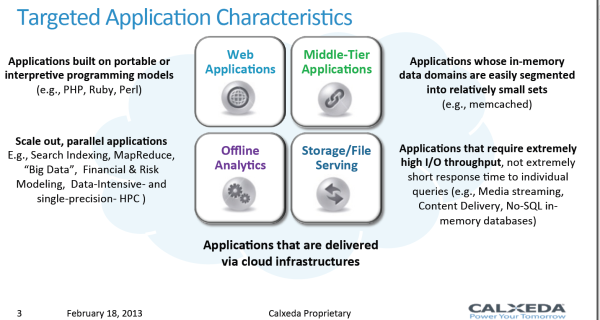Calxeda's ARM server tested
by Johan De Gelas on March 12, 2013 7:14 PM EST- Posted in
- IT Computing
- Arm
- Xeon
- Boston
- Calxeda
- server
- Enterprise CPUs
Finding a Good Fit
The previous benchmarks have shown that the first Calxeda server is not for the general IT market. As the slide below shows, Calxeda targets four kinds of workloads:
- Web applications
- Middle-tier applications
- Offline analytics
- Storage and file serving
For applications such as Memcache, the ECX-1000 1.4GHz lacks bandwidth and memory capacity. Once a Cortex-A15 based server is available, this can change quickly as performance will improve significantly and the amount of memory per CPU can be quadrupled to 16GB.
We did not test it yet, but our own experience tells us that the majority of the "scale out" applications are out of reach. Especially in the financial and risk modeling world, top performance and ultra low response times are prioritized.
Calxeda based Boston servers are already making inroads as storage servers. There is little doubt that a low power processing unit makes a lot of sense in a storage server.
That leaves the question whether or not Calxeda's latest server can make it in the web server and Content Delivery world. Calxeda claims 5W per server node, and no more than 250W for the complete server chassis with 24 server nodes. That's pretty cool, but currently there is another solution. Two octal-core Xeon E5 deliver no less 32 threads running on top of 16 very potent cores. Add a virtualization layer and you get tens of servers. The only limitation is typically the amount of RAM.
So assume you are a hosting provider. Which server do you use as your building block? You've got two choices:
The standard one, the Intel Xeon E5 server. The advantages are excellent performance whenever you need it, whether your application scales well with more threads or not. The Xeon can address up to 384GB of affordable RAM (16GB DIMMs). If that's not enough, 768GB is possible with more expensive LR-DIMMs.
Those are impressive specs, but what if most of your customers just want to host medium sized web sites, sites that are rich on content but rather low on processing requirements? Can the Boston Viridis server attract such users with a much lower power consumption? How far can you go with slicing and dicing the Xeon's monstruous performance into small virtual pieces? We decided to find out.











99 Comments
View All Comments
JohanAnandtech - Wednesday, March 13, 2013 - link
Hmmm ... There is almost no info on how that hypervisor works. It is hard to imagine that kind of system would scale very well. How does it keep Cache coherent? Do you have info on that?timbuktu - Wednesday, March 13, 2013 - link
I can't speak directly to ScaleMP, but it looks similar to NUMALink.http://en.wikipedia.org/wiki/NUMAlink
Reading through this article about Calxedas, great job BTW, I couldn't help but think about the old SGI hardware that seemed pretty similar with MIPs (and later Itanium) processors connected through a switch with NUMALink. I haven't played with NUMALink directly in almost a decade, but back then cheaper Altix slabs were ring topology while higher end hardware was switched. In the end though, you could put together a bunch of 1U racks together and have a single system image. Like you mentioned though, cache coherency was exceptionally important. Since we have a uv here, I can point you to the documentation for that box.
http://techpubs.sgi.com/library/tpl/cgi-bin/getdoc...
Everything old is new again, I suppose. Well, except NUMAlink never went away. =D
Tunrip - Wednesday, March 13, 2013 - link
I'd be interested in knowing how the Xeon compared if you did the same test without the virtual machines.JohanAnandtech - Wednesday, March 13, 2013 - link
The website won't scale to 32 logical cores I am afraid... but we can try to see how far we can getColin1497 - Wednesday, March 13, 2013 - link
A better question might be "is 24 VM's a logical number to use?" Would more or fewer VM's work better? The appearance is that you have 24VM's because you have 24 ARM nodes?duploxxx - Wednesday, March 13, 2013 - link
very interesting, loved reading it. But although early in the ball game I do think there are other way better solutions in the pipe-line from the big OEM:HP Moonshot
http://h17007.www1.hp.com/us/en/iss/110111.aspx
JohanAnandtech - Wednesday, March 13, 2013 - link
Isn't remarkable how PR people manage to fill so many pages with "extreme" and "the future" without telling anything. Frustation became even higher when I clicked "get the facts" page. That is more like "You are not getting any facts at all".DuckieHo - Wednesday, March 13, 2013 - link
Since these are set up as webservers, what's the power consumption at say 20-40% load? Usually there is some load instead of completely idle.JohanAnandtech - Wednesday, March 13, 2013 - link
Good suggestion... you'll like to see a step by step power measurement like SpecPower right? Let me try that.DanNeely - Wednesday, March 13, 2013 - link
I'd be interested in seeing where, and what happens when you start pushing single chips to and slightly beyond their limits. Calxeda's hardware's proved competitive on a very friendly workload (which I didn't really expect would happen until their A15 product); but in the real world a set of small websites are unlikely to all have equal load levels. Virtual servers on larger CPUs should give more headroom for load spikes; so knowing what the limits on Calxeda's hardware are strikes me as fairly important.